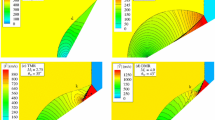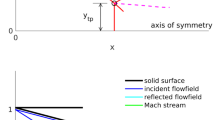Abstract
The transition boundary separating the regions of regular and Mach reflections for a planar shock moving in argon and interacting with an inclined wedge in a shock tube is investigated using flow-field simulations produced by high-resolution computational fluid dynamics (CFD). The transition boundary is determined numerically using a modern and reliable CFD algorithm to solve Euler’s inviscid equations of unsteady motion in two spatial dimensions with argon treated as a polytropic gas. This numerically computed transition boundary for inviscid flow, without a combined thermal and viscous boundary layer on the wedge surface, is determined by post-processing many closely stationed flow-field simulations to accurately determine the transition-boundary point when the Mach stem of the Mach-reflection pattern just disappears, and this pattern then transcends into that of regular reflection. The new numerical transition boundary for argon is shown to agree well with von Neumann’s closely spaced sonic and extreme-angle boundaries for weak incident shock Mach numbers from 1.0 to 1.55, but it deviates upward and above the closely spaced sonic and extreme-angle boundaries by almost \(2^\circ \) at larger shock Mach numbers from 1.55 to 4.0. This upward trend of the numerical transition boundary for this sequel case with monatomic gases like argon (\(\gamma =5/3\)) and no boundary layer on the wedge surface (inviscid flow) is similar to the previous finding for the case of diatomic gases and air (\(\gamma =7/5\)). An alternative method used to determine one point on the transition boundary between regular and Mach reflections, from a collection of Mach-reflection patterns with a constant-strength shock and different far-field wedge angles, by linear and higher-order polynomial extrapolations to zero for triple-point trajectories versus wedge angle, is compared to the present method of using near-field data that are close to and surround the new transition boundary. Such extrapolation methods are shown to yield a different transition-boundary estimate that corresponds to the mechanical-equilibrium boundary of von Neumann. Finally, the significance of the computed inviscid transition boundary between regular and Mach reflections for monatomic and diatomic gases is explained relative to the case of viscous flow with a combined thermal and viscous boundary layer on the wedge surface.



















Similar content being viewed by others
References
von Neumann, J.: Oblique reflection of shocks. Explosive Research Report No. 12, Navy Department, Bureau of Ordnance, U.S. Department of Communication Technology Services No. PB37079 (1943) (John von Neumann, Collected Works). Pergamon Press, Oxford, vol. 6, pp. 238–299 (1963)
Ben-Dor, G., Glass, I.I.: Domains and boundaries of non-stationary oblique shock-wave reflexions. 1. Diatomic gas. J. Fluid Mech. 92(3), 459–496 (1979). https://doi.org/10.1017/S0022112079000732
Ben-Dor, G., Glass, I.I.: Domains and boundaries of non-stationary oblique shock-wave reflexions. 2. Monatomic gas. J. Fluid Mech. 96(4), 735–756 (1980). https://doi.org/10.1017/S0022112080002339
Ben-Dor, G.: Shock Wave Reflection Phenomena, 1e, 2e. Springer, Berlin (1991, 2007). ISBN 978-3-540-71381-4. https://doi.org/10.1007/978-1-4757-4279-4
Glass, I.I., Sislian, J.P.: Nonstationary Flows and Shock Waves. Clarendon Press, Oxford (1994)
Colella, P., Henderson, L.F.: The von Neumann paradox for the diffraction of weak shock waves. J. Fluid Mech. 213, 71–94 (1990). https://doi.org/10.1017/S0022112090002221
Semenov, A.N., Berezkina, M.K., Krassovskaya, I.V.: Classification of pseudo-steady shock wave reflection types. Shock Waves 22(4), 307–316 (2012). https://doi.org/10.1007/s00193-012-0373-z
Hornung, H.: Regular and Mach reflection of shock waves. Annu. Rev. Fluid Mech. 18, 33–58 (1986). https://doi.org/10.1146/annurev.fl.18.010186.000341
Bleakney, W., Taub, A.H.: Interaction of shock waves. Rev. Mod. Phys. 21(4), 584–605 (1949). https://doi.org/10.1103/RevModPhys.21.584
Kawamura, R., Saito, H.: Reflection of shock waves—1. Pseudostationary case. J. Phys. Soc. Jpn. 11(5), 584–592 (1956). https://doi.org/10.1143/JPSJ.11.584
Henderson, L.F., Takayama, K., Crutchfield, W.Y., Itabashi, S.: The persistence of regular reflection during strong shock diffraction over rigid ramps. J. Fluid Mech. 431, 273–296 (2001). https://doi.org/10.1017/S0022112000003165
Kobayashi, S., Adachi, T., Suzuki, T.: On the unsteady transition phenomenon of weak shock waves. Theor. Appl. Mech. Jpn. 49, 271–278 (2000)
Smith, L.G.: Photographic investigation of the reflection of plane shocks in air. Division 2, National Defence Research Committee of the Office of Scientific Research and Development, OSRD Report No. 6271 (1945)
Henderson, L.F., Lozzi, A.: Experiments on transition of Mach reflexion. J. Fluid Mech. 68(1), 139–155 (1975). https://doi.org/10.1017/S0022112075000730
Henderson, L.F., Siegenthaler, A.: Experiments on the diffraction of weak blast waves: the von Neumann paradox. Proc. R. Soc. Lond. A 369(1739), 537–555 (1980). https://doi.org/10.1098/rspa.1980.0015
Walker, D.K., Dewey, J.M., Scotten, L.N.: Observation of density discontinuities behind reflected shocks close to the transition from regular to Mach reflection. J. Appl. Phys. 53(3), 1398–1400 (1982). https://doi.org/10.1063/1.329871
Lock, G.D., Dewey, J.M.: An experimental investigation of the sonic criterion for transition from regular to Mach reflection of weak shock waves. Exp. Fluids 7(5), 289–292 (1989). https://doi.org/10.1007/BF00198446
Smith, W.R.: Mutual reflection of two shock waves of arbitrary strengths. Phys. Fluids 2(5), 533–541 (1959). https://doi.org/10.1063/1.1705945
Henderson, L.F., Lozzi, A.: Further experiments on transition to Mach reflexion. J. Fluid Mech. 94(3), 541–559 (1979). https://doi.org/10.1017/S0022112079001178
Barbosa, F.J., Skews, B.W.: Experimental confirmation of the von Neumann theory of shock wave reflection transition. J. Fluid Mech. 472, 263–282 (2002). https://doi.org/10.1017/S0022112002002343
Herron, T., Skews, B.: On the persistence of regular reflection. Shock Waves 21(6), 573–578 (2011). https://doi.org/10.1007/s00193-011-0341-z
Hryniewicki, M.K., Gottlieb, J.J., Groth, C.P.T.: Transition boundary between regular and Mach reflections for a moving shock interacting with a wedge in inviscid and polytropic air. Shock Waves 27(4), 523–550 (2017). https://doi.org/10.1007/s00193-016-0697-1
Alzamora Previtali, F., Timofeev, E., Kleine, H.: On unsteady shock wave reflections from wedges with straight and concave tips. 45th AIAA Fluid Dynamics Conference, Dallas, TX, AIAA Paper 2015-2642 (2015). https://doi.org/10.2514/6.2015-2642
Henderson, L.F., Crutchfield, W.Y., Virgona, R.J.: The effects of thermal conductivity and viscosity of argon on shock waves diffracting over rigid ramps. J. Fluid Mech. 331, 1–36 (1997). https://doi.org/10.1017/S0022112096003850
Thompson, P.A.: Compressible-Fluid Dynamics. Rensselaer Polytechnic Institute Press, New York (1988)
Courant, R., Friedrichs, K.O.: Supersonic Flow and Shock Waves. Interscience Publisher, New York (1948)
Hryniewicki, M.K., Groth, C.P.T., Gottlieb, J.J.: Parallel implicit anisotropic block-based adaptive mesh refinement finite-volume scheme for the study of fully resolved oblique shock wave reflections. Shock Waves 25(4), 371–386 (2015). https://doi.org/10.1007/s00193-015-0572-5
Freret L., Groth, C.P.T.: Anisotropic non-uniform block-based adaptive mesh refinement for three-dimensional inviscid and viscous flows. 22nd AIAA Computational Fluid Dynamics Conference, Dallas, TX, AIAA Paper 2015-2613 (2015). https://doi.org/10.2514/6.2015-2613
McDonald, J.G., Sachdev, J.S., Groth, C.P.T.: Application of Gaussian moment closure to microscale flows with moving embedded boundaries. AIAA J. 52(9), 1839–1857 (2014). https://doi.org/10.2514/1.J052576
Northrup, S.A., Groth, C.P.T.: Parallel implicit adaptive mesh refinement scheme for unsteady fully-compressible reactive flows. 21st AIAA Computational Fluid Dynamics Conference, Fluid Dynamics and Co-located Conferences, San Diego, CA, AIAA Paper 2013-2433 (2013). https://doi.org/10.2514/6.2013-2433
Williamschen, M.J., Groth, C.P.T.: Parallel anisotropic block-based adaptive mesh refinement algorithm for three-dimensional flows. 21st AIAA Computational Fluid Dynamics Conference, Fluid Dynamics and Co-located Conferences, San Diego, CA, AIAA Paper 2013-2442 (2013). https://doi.org/10.2514/6.2013-2442
Zhang, Z.J., Groth, C.P.T.: Parallel high-order anisotropic block-based adaptive mesh refinement finite-volume scheme. 20th AIAA Computational Fluid Dynamics Conference, Fluid Dynamics and Co-located Conferences, Honolulu, HI, AIAA Paper 2011-3695 (2011). https://doi.org/10.2514/6.2011-3695
Gao, X., Northrup, S.A., Groth, C.P.T.: Parallel solution-adaptive method for two-dimensional non-premixed combusting flows. Prog. Comput. Fluid Dyn. 11(2), 76–95 (2011). https://doi.org/10.1504/PCFD.2011.038834
Gao, X., Groth, C.P.T.: A parallel solution-adaptive scheme for three-dimensional turbulent non-premixed combusting flows. J. Comput. Phys. 229(9), 3250–3275 (2010). https://doi.org/10.1016/j.jcp.2010.01.001
Gao, X., Groth, C.P.T.: A parallel adaptive mesh refinement algorithm for predicting turbulent non-premixed combusting flows. Int. J. Comput. Fluid Dyn. 20(5), 349–357 (2006). https://doi.org/10.1080/10618560600917583
Sachdev, J.S., Groth, C.P.T., Gottlieb, J.J.: A parallel solution-adaptive scheme for multi-phase core flows in solid propellant rocket motors. Int. J. Comput. Fluid Dyn. 19(2), 159–177 (2005). https://doi.org/10.1080/10618560410001729135
Hryniewicki, M.K.: On the transition boundary between regular and Mach reflections from a wedge in inviscid and polytropic gases. PhD Thesis, UTIAS, University of Toronto (2016)
von Becker, E.: Instationäire grenzschichten hinter verdichtungsstößen und expansionswellen. Prog. Aerosp. Sci. 1, 104–173 (1961). https://doi.org/10.1016/0376-0421(61)90005-7
Hornung, H.G., Taylor, J.R.: Transition from regular to Mach reflection of shock waves. Part 1. The effect of viscosity in the pseudosteady case. J. Fluid Mech. 123, 143–153 (1982). https://doi.org/10.1017/S0022112082002997
Hornung, H.: The effect of viscosity on the Mach stem length in unsteady strong shock reflection. In: Meier, G.E.A., Obermeier, F. (eds.) Flow of Real Fluids. Lecture Notes in Physics, vol. 235, pp. 82–91. Springer, Berlin (1985). https://doi.org/10.1007/3-540-15989-4_73
Reichenbach, H.: Roughness and heated-layer effects on shock-wave propagation and reflection—experimental results. Ernst Mach Institute, EMI Report E24/85. West Germany, Freiburg (1985)
Lee, J.-H., Glass, I.I.: Pseudo-stationary oblique-shock-wave reflections in frozen and equilibrium air. Prog. Aerosp. Sci. 21(1), 33–80 (1984). https://doi.org/10.1016/0376-0421(84)90003-4
Shirouzu, M., Glass, I.I.: Evaluation of assumptions and criteria in pseudostationary oblique shock-wave reflections. Proc. R. Soc. Lond. A 406(1830), 75–92 (1986). https://doi.org/10.1098/rspa.1986.0065
Wheeler, J.: An interferometric investigation of the regular to Mach reflection transition boundary in pseudostationary flow in air. UTIAS Technical Note No. 256, University of Toronto Institute for Aerospace Studies (1986)
Kleine, H., Timofeev, E., Hakkaki-Fard, A., Skews, B.: The influence of Reynolds number on the triple point trajectories at shock reflection off cylindrical surfaces. J. Fluid Mech. 740, 47–60 (2014). https://doi.org/10.1017/jfm.2013.634
Acknowledgements
The contributions of Lucie Freret in making the anisotropic algorithm for adaptive mesh refinement more effective and computationally efficient are greatly appreciated. Important papers on shock-induced boundary layers sent by Hans G. Hornung to the first author are gratefully acknowledged. Mach-reflection discussions with Evgeny Timofeev by the first and third authors were very helpful and much appreciated. Computational resources for performing all of the calculations reported in this research were provided by the SciNet High Performance Computing Consortium at the University of Toronto and Compute/Calcul Canada, via funding from the Canada Foundation for Innovation (CFI) and the Province of Ontario, Canada.
Author information
Authors and Affiliations
Corresponding author
Additional information
Communicated by E. Timofeev.
Publisher's Note
Springer Nature remains neutral with regard to jurisdictional claims in published maps and institutional affiliations.
Rights and permissions
About this article
Cite this article
Gottlieb, J.J., Hryniewicki, M.K. & Groth, C.P.T. Transition boundary between regular and Mach reflections for a moving shock interacting with a wedge in inviscid and polytropic argon. Shock Waves 29, 795–816 (2019). https://doi.org/10.1007/s00193-018-0873-6
Received:
Revised:
Accepted:
Published:
Issue Date:
DOI: https://doi.org/10.1007/s00193-018-0873-6




